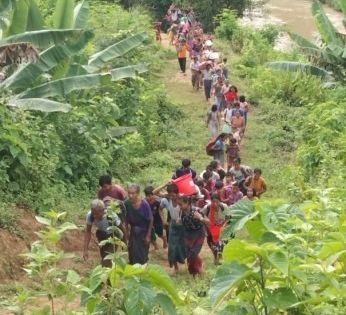Mizoram: Biometric details of 12,170 refugees from Myanmar collected
By IANS | Updated: October 8, 2025 15:25 IST2025-10-08T15:24:05+5:302025-10-08T15:25:04+5:30
Aizawl, Oct 8 Mizoram authorities have so far collected biometric details of around 39 per cent of the ...

Mizoram: Biometric details of 12,170 refugees from Myanmar collected
Aizawl, Oct 8 Mizoram authorities have so far collected biometric details of around 39 per cent of the nearly 31,300 Myanmar refugees taking shelter in the state after fleeing their country following the military coup in February 2021.
An official of the Mizoram Home Department said that biometric data of around 12,170 refugees from Myanmar have been collected so far.
"Serchhip district administration in central Mizoram first launched the biometric enrolment drive for the refugees on July 30 and subsequently other districts initiated the biometric enrolment process," the official said.
Following the advice of the Ministry of Home Affairs, the biometric enrolment process has been underway through the 'Foreigners Identification Portal and Biometric Enrolment'.
The official admitted that the process has been facing multiple challenges, including technical difficulties and unstable internet connectivity in remote areas and added that despite these problems, the authorities have managed to continue the enrolment process, though at a slow speed.
Besides the Myanmar refugees, around 3,000 migrants from the Chittagong Hill Tracts (CHT) of Bangladesh have taken shelter in three districts of Mizoram over the past two years.
Most of the Bangladeshi refugees (around 2,000) have sheltered in Lawngtlai district in southern Mizoram, which borders both Myanmar and Bangladesh.
Tribal refugees from Bangladesh have also been accommodated in Lunglei district and Serchhip district. Both the Myanmar and Bangladesh refugees are sheltered in camps, relatives' and rented houses in all the 11 districts in the Northeastern state.
The Home Department official said that it is easier to collect the biometric details of those refugees taking shelter in the camps but it is problematic for those staying in relatives' and rented houses in hundreds of villages.
"To tackle this problem, the concerned authorities in the districts have sought the help of Village Councils and Civil Society Organisations specially the Young Mizo Association YMA)," the official said.
Along with biometric data, the enrolment process includes the collection of biographical details including names, addresses, parents' names, and any employment histories both in Myanmar and in Mizoram.
The Mizoram government before starting of the collection of biometric details of the refugees has provided vigorous training to the district-level officials to collect biometrics and biographic data of the refugees taking shelter in the state, which shares 510 km and 318 km unfenced international borders with Myanmar and Bangladesh, respectively.
After a military coup in Myanmar in February 2021, refugees, including women and children from the neighbouring country, started coming to Mizoram seeking shelter, and now their numbers have increased to around 31,300.
The Bangladeshi Bawm community tribals from CHT have also been staying in Mizoram for over two years after they fled from their country due to ethnic troubles, following the Bangladesh Army's launch of a crackdown on the tribals.
The Myanmar refugees, mostly Chin tribes having almost full ethnic and cultural similarity with the majority Mizos of Mizoram while the Bawm, also known as Bawmzo, are a small ethnic group primarily residing in the CHT of Bangladesh, and they have also almost full ethnic and cultural resemblance with the Mizos of Mizoram.
Myanmar's Chin state shares 510 km of mountainous borders with six Mizoram districts -- Champhai, Siaha, Lawngtlai, Hnahthial, Saitual and Serchhip. Mizoram's three districts, Mamit, Lunglei and Lawngtlai, share a 318 km-long border with Bangladesh.
Disclaimer: This post has been auto-published from an agency feed without any modifications to the text and has not been reviewed by an editor
Open in app